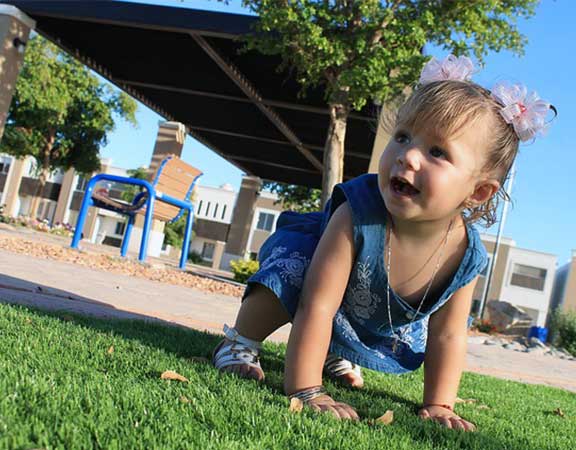“What do you mean Fletcher’s not crawling yet?”
I’d been waiting to put my son on the swings at Mommy & Me, and another mom had overheard me bemoaning his steadfast refusal to move under his own power. “He’s 8 1/2 months and still not crawling?” she asked incredulously. I stood speechless.
I was the bad mom whose kid didn’t crawl, would never crawl, and thus would never get into a good college. Or at least that’s how it played out in my new-mom neurotic mind.
“He’s probably just content where he is,” my pediatrician said, unconcerned when I brought it up at Fletcher’s 9-month well-baby visit.
Basically, in my doctor’s gentle way, she was telling me to relax. But how do you know when you’re making a big deal out of nothing or if your concerns are spot-on?
To help you decide, here’s a guide to how babies go from facile kickers to speed walkers.
Before They Get Mobile
A baby’s first few weeks are spent stretching out his arms and legs, basically “unfolding” from the scrunched up position he was in for so many months inside the womb. Within the first month or two, and certainly by month four, he should be actively lifting his hips and wriggling and kicking his legs.
“The baby is beginning to test the waters to see what he can do with those legs,” explains Charles Shubin, MD, assistant professor of pediatrics at Johns Hopkins University, in Baltimore.
If your baby’s legs appear a bit bowed, don’t be alarmed. Eventually, most infants’ legs straighten out by themselves, adds Dr. Shubin. And don’t be afraid to prop baby up on his feet. “The stresses of standing help straighten bones,” he says.
Between 4 and 6 months, babies discover their chubby little feet, grabbing them and putting them in their mouths. They may also use their feet in the same way they use their hands, picking up toys and exploring the floor.
What to Watch For: You may notice that your baby’s feet curve inward. In most cases, this is quite normal — another result of being cramped in the womb.
If the bones are flexible enough for your paediatrician to gently pull the feet into a straight position, there’s no need to worry, says Kristin Hannibal, MD, clinic director of the Primary Care Centre at the Children’s Hospital of Pittsburgh. But if they seem rigid, you may be referred to a paediatric orthopedist.
Contact your pediatrician if by 3 to 6 months, your child isn’t wriggling her legs, seems to flop in your arms, or she doesn’t put her feet down when you try to support her in a standing position.
Readiness to Crawl
Sometime between 7 and 10 months babies get up on their hands and knees and begin to rock back and forth. This signals their readiness to start crawling. Of course, some kids find other ways to get around, such as scooting on their bottom.
Whether babies crawl or not may be simply a matter of temperament. “Some babies are more driven; other babies are more laid-back, happy to play with what’s within their reach,” says Dr. Hannibal.
Indeed, some kids never crawl. It’s usually nothing to stress over as long as they’re meeting their other developmental milestones, such as pulling to stand, cruising on furniture, and using their hands properly, explains Dr. Hannibal.
What to Watch For: If your child can’t support his body weight or doesn’t have energy to move around, tell your pediatrician.
Your baby may have low muscle tone (when the brain doesn’t send nerve impulses to the muscles or the muscles don’t receive them, which can lead to muscle weakness) or maybe he’s not spending enough time on his tummy, says pediatric physical therapist Gay Girolami, executive director of the Pathways Center, in Glenview, Illinois.
Another potential red flag: Tell the pediatrician if your baby isn’t scooting, rolling, or crawling at all by 1 year, or seems to favor one side, particularly if she’s not meeting other developmental milestones, says Dr. Hannibal.
This could be harmless, or it may indicate a neurological problem, such as cerebral palsy, which is diagnosed in about 8,000 babies annually.
Cruise Control
Around 9 or 10 months, kids’ curiosity motivates them to pull themselves up for a better view of the world. And by 11 to 12 months, they’re generally taking their first steps while holding on to the furniture — known as cruising — or your hands.
During this period, you might also notice that her feet appear flat. That’s partly because the arch hasn’t entirely formed yet and because it’s somewhat hidden by a fat pad, which disappears around age 2 or 3.
While low arches in young kids are normal, feet that remain flat may need shoes with arch supports to encourage the arch to take shape, says podiatrist Alan Woodle, DPM, of the Greenwood Foot and Ankle Center, in Seattle. Otherwise, baby shoes shouldn’t have any support.
Your baby’s feet may also turn in. Again, this is usually nothing to worry about and is likely the result of baby’s position in the womb.
Generally, both feet and legs straighten out by 18 months, and unless the in-toeing is totally rigid (which would require a visit to an orthopedist), causing pain or interfering with your child’s ability to walk, most pediatricians allow children to outgrow it.
What to Watch For: Does your child only use her arms to pull to stand, seem to have difficulty getting up because her legs are stiff, fall more than would be expected, or frequently fall to one side?
These are red flags that could signal a range of problems, including joint disorders, spinal cord abnormalities, and cerebral palsy. Discuss the signs with your paediatrician.



Art Class kids’ apparel and accessories collection Target X MOI
Authorhttps://www.parents.com/baby/development/crawling/baby-physical-growth-delayed-crawling